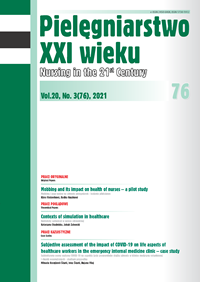Konteksty symulacji w opiece zdrowotnej
DOI:
https://doi.org/10.2478/pielxxiw-2021-0024Słowa kluczowe:
symulacja, edukacja, pielęgniarstwo, opieka zdrowotnaAbstrakt
KONTEKSTY SYMULACJI W OPIECE ZDROWOTNEJ
Wprowadzenie. Symulacja w kształceniu przyszłych kadr pielęgniarskich ma swój początek już w 1911 roku. Postęp technologiczny na przestrzeni lat sprawił, iż obecnie w Centrach Symulacji Medycznej wykorzystuje się sprzęt najwyższej klasy, kształcenie poparte jest standardami a studenci doskonalą swoje umiejętności, nie tylko te praktyczne ale te z komunikacją w zespole czy pracą pod presją czasu również. Ponadto coraz bardziej popularna staję się symulacja wirtualna, która w obecnym czasie pandemii związanej z koronawirusem stwarza możliwość realizacji zajęć.
Cel. Przedstawienie ewolucji i znaczenia symulacji medycznej w edukacji pielęgniarskiej.
Metoda. Przegląd niesystematyczny literatury przedmiotu, dobór dokumentów zgodny z celem opracowania za okres w latach 2009-2021 w języku polskim i angielskim.
Podsumowanie. Centra symulacji medycznej to miejsca służące nie tylko rozwojowi przyszłych kadr medycznych, ale również to przestrzeń idealna do doskonalenia zawodowego już aktywnie pracującej kadry medycznej.
Bibliografia
1. NLN Board of Governors. A Vision for Teaching with Simulation. NLN Vision Series. April, 2015. http://www.nln.org/docs/default-source/about/nln-vision-series-(position statements)/vision-statement-a-vision-for-teaching-with-simulation.pdf?sfvrsn=2.
2. Lioce L, Lopreiato J, Downing D, i wsp. Healthcare Simulation Dictionary – Second Edition. Rockville, MD: Agency for Healthcare Research and Quality. 2020; 44: 21.
3. Ryall T, Judd BK, Gordon CJ. Simulation-based assessments in health professional education: A systematic review. Journal of Multidisciplinary Healthcare. 2016, 9: 69-82.
4. Galloway SJ. Simulation Techniques to Bridge the Gap Between Novice and Competent Healthcare Professionals. The Online Journal of Issues in Nursing. 2009, 14(2,3).
5. Hopkins D. red. Framework for Action on Interprofessional Education and Collaborativ Practice (WHO/HRH/HPN/10.3) World Health Organisation. http://www.who.int/hrh/nursing_midwifery/en/.
6. INACSL Standards Committee. INACSL Standards of Best Practice: SimulationSM Simulation-enhanced interprofessional education (sim-IPE). Clinical Simulation in Nursing. 2016, 12: 34-38.
7. Chiniara G, Cole G, Brisbin K, et al. Simulation in healthcare: A taxonomy and a conceptual framework for instructional design and media selection. Medical Teacher. 2013; 35(8): 1380-1395.
8. Bogossian F, Cooper S, Kelly M, et al. The use of simulation as a learning approach to non technical skills awareness in final year student nurses. Clinical Simulation in Nursing. 2019; 11(3): 425-430.
9. Shepherd I, Burton T, A conceptual framework for simulation in healthcare education – The need. Nurse Education Today. 2019; 76(1): 21-25.
10. Brien R, Mould J. Interprofessional education. [w:] Riley RH, red. Manual of Simulation of healthcare. United Kingdom: Oxford University Press; 2016, s. 141-160.
11. Team STEPPS. https://www.ahrq.gov/teamstepps/index.html (dostęp 28.12.2020).
12. Benner P. From novice to expert. American Journal of Nursing.1982; 82(3): 402-407.https://www.medicalcenter.virginia.edu/therapy-services/3 - Benner - Novice to Expert-1.pdf.
13. Jeffries PR, Rizzolo MA. Designing and implementing models for the innovative use of simulation to teach nursing care of ill adults and children : a national, multisite, multi-method study. National League for Nursing; 2016, s. 1-17.
14. Jeffries PR, Rogers KJ. Theoretical framework for simulation design. [w:] Jeffries P, red. Simulation in nursing education: From conceptualization to evaluation 2nd edition. New York: National League for Nursing; 2012, s. 25-42.
15. Cowperthwait A. NLN/Jeffries Simulation Framework for Simulated Participant Methodology. Clinical Simulation in Nursing. 2020; 42: 12-21.
16. Regulation of the Minister of Science and Higher Education of May 9, 2012 on education standards for the fields of study: medicine, dentistry and dentistry, pharmacy, nursing and obstetrics. Journal of Laws. 2012, poz. 631.
17. Regulation of the Minister of Science and Higher Education of 26 July 2019 on training standards for the profession of a doctor, dentist, pharmacist, nurse, midwife, laboratory diagnostician, physiotherapist and paramedic. Journal of Laws. 2019; poz 1573.
18. Resolution No. 103/IV/2017 of June 22, 20217 on the implementation of classes in Medical Simulation Centers - multi and monoprofile in the field of nursing and obstetrics of the National Accreditation Council of Schools of Nurses and Midwives in Poland https://www.gov.pl/web/zdrowie/krajowa-rada-akredytacyjna-szkol-pielegniarek-i-poloznych-kraszpip-pdf (dostęp 28.12.2020)
19. Motola I, Devine LA, Chung HS, i wsp. Simulation in healthcare education: A best evidence practical guide. Medical Teacher AMEE Guide No. 82. 2013; 35(10): 42-159.
20. Padilha JM, Machado PP, Ribeiro AL, i wsp. Clinical Virtual Simulation in Nursing Education. Clinical Simulation in Nursing. 2018; 15: 13-18.
21. Sperl-Hillen J, O’Connor PJ, Ekstrom HL, i wsp. Educating resident physicians using virtual case-based simulation improves diabetes management: a randomized controlled trial. Academic medicine: journal of the Association of American Medical Colleges. 2014; 89(12): 1664-1673.
22. Tschannen D, Aebersold M, McLaughlin E, i wsp. Use of virtual simulations for improving knowledge transfer among baccalaureate nursing students. Journal of Nursing Education and Practice. 2012; 2(3): 15-24.
23. Using Distance Simulation to Supplement Clinical Hours. https://oxfordmedicalsimulation.com/tag/virtual-reality-simulation (dostęp 5.01.2021).
24. the procedure for putting on the coveralls. Warsaw Medical University. https://www.youtube.com/watch?v=qcu7UKJi0OA (dostęp 9.01.2021).
25. MOPR and DPS employees trained how to fight the coronavirus. https://radioszczecin.pl/1,408545,pracownicy-mopr-u-i-dps-ow-szkolili-sie-jak-walc (dostęp 9.01.2021).
26. Medical Simulation Center. Apparatus treatment of respiratory failure. http://www.csm.umed.wroc.pl/2020/12/07/aparaturowe-leczenie-niewydolnosci-oddechowej/ (dostęp 9.01.2021).
27. COVID training. Medical University of Lodz. https://umed.pl/szkolenia-covid-2 (dostęp 9.01.2021).
28. Coelho P. The Pilgrimage. HarperCollins Publishers; 2005.
Pobrania
Opublikowane
Numer
Dział
Licencja
Prawa autorskie (c) 2021 Autorzy

Utwór dostępny jest na licencji Creative Commons Uznanie autorstwa – Użycie niekomercyjne – Bez utworów zależnych 4.0 Międzynarodowe.




